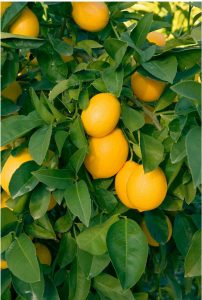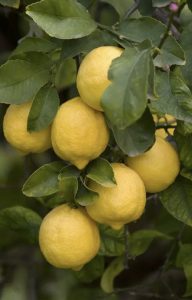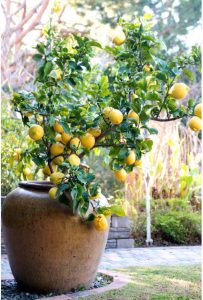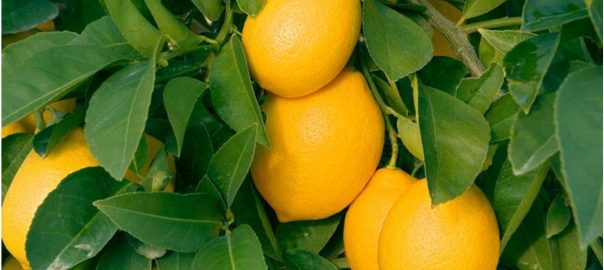Savour the Citrus!
We grow so many different edibles and ornamentals in our tunnelhouses, yet there’s one that is boasted about like no other – the lemon! Along with a range of other citrus suitable for undercover growing, lemons grab our attention, perhaps because they remind us of exotic winter-getaways – or even a good old
G & T! While some cool climate growers manage to coax lemons from a tree planted hard-up against a heat-retaining wall, the rest of us must rely on our tunnelhouses for this fruit, and in many ways, our undercover citrus are likely to be more perfect than those grown outdoors. Provided you know how to set up your tunnelhouse citrus for success, and how to tend to these exciting trees, you could be enjoying lemons, limes, grapefruit, mandarins, and even oranges, year-round. And the best news of all, is that right now is the time to source your plants and prepare a space for them in your tunnelhouse!

Source
Citrus are traditionally planted at the start of winter, when moisture levels are higher and can aid the rapid development of roots. The exception to the rule is if you live in a mountainous region that experiences severe winters (in which case, it pays to plant in early autumn). Choosing citrus varieties for your tunnelhouse will be largely dictated by the space you intend giving the tree (or trees). If you intend devoting your entire tunnelhouse to citrus (and some growers do, by having an extra tunnelhouse on the property just for this purpose), you won’t necessarily have to head to dwarf varieties. However, if you plan to devote just a section of your tunnelhouse to a citrus tree, or to house a container-grown citrus in the tunnelhouse only over the colder months, you may want to consider dwarf varieties.
Dwarf citrus are traditionally grafted onto the rootstock ‘Flying Dragon,’ a form of the citrus Poncirus trifoliata, which originates from Japan. And while this rootstock reduces the size of trees to around 1.5-2m in height, it doesn’t prevent the harvest of fruit from being prolific and full sized. Dwarf varieties of citrus are available at garden centres or can be ordered online.
Groundwork
Whether you plan to plant your citrus in-ground or in a container, growing medium preparation is the same. Citrus will not tolerate wet feet, and if you grow in poorly drained soil, root rot will potentially be a problem. If you are not familiar with creating your own citrus growing medium, head to the garden centre for a pre-prepared citrus mix (or use a cacti mix if you already have some). If you want to create your own growing medium, mix together in a wheelbarrow (or other large vessel) 5 buckets of lightly-mulched, untreated, organic bark, 1 bucket of perlite (or untreated organic biochar, vermiculite, or sharp sand), and 1 bucket of compost. As you are planting into the cold, dormant season, refrain from adding fertiliser (even if organic) at this stage (for exceptions, see note below).
Planting
If you are growing in-ground, dig out the existing soil to create a planting hole twice the depth and width of your nursery-purchased tree. Add a few centimetres of mix into the base of the hole. Back-fill as you plant, with your prepared mix. If you are growing in a container, choose it carefully, and be mindful of what is it made of. A terracotta container has the advantage of absorbing heat during the day, and releasing this back into the growing medium at night. However, terracotta is heavy, and it will be be more difficult to move the plant out of the greenhouse when the warmer weather arrives (placing it on a stand with wheels attached, and choosing a container with handles, can help). Plastic containers are not as attractive or sustainable as teracotta, but they are light. When it comes to the size of the container, bear in mind that the larger the vessel, the more success you will have with the plant. Having said that, any container that is twice the width and one and a half times the depth of the root ball of your tree, will be adequate.
Whether planting in a container or in-ground, if the planter bag is tightly packed with roots, and they are heading around rather than down, tease them out gently before planting, and endeavour to splay them out a little at the base as you place the plant in position. Gently firm the growing mix around the roots as you backfill, and don’t allow soil to come further up the trunk than it was previously. Water your newly planted tree to moisten (not wet) the growing medium.
Citrus will do best if planted away from drafts (they prefer a winter temperature of around 10°C), so choose a sunny spot from doors or vents.
Maintenance
While your tunnelhouse citrus is quite likely to produce fruit year-round, its active growing period is spring and summer, with sweet scented blossom appearing in spring. For that reason, the plant doesn’t require fertilising during winter. There is one exception to this rule, however: If growth patterns are a little out of character because of a warmer-than-usual cool season, your citrus may continue to develop foliage, and even begin to flower, during winter. In this case, light fertilising (about a quarter of what you would apply in the active growing period) can be carried out. Otherwise, refrain from fertilising until spring and summer, at which stage a commercial citrus-specific fertiliser can be used according to instructions. If you want to make your own citrus fertiliser, prepare a pile of of kelp mixed in with your regular compost, sterilised sheep pellets, and comfrey leaves, and leave it to rot down for 3-4 months. Apply as a 2-3cm mulch in spring, and as a liquid feed (obtained by soaking the ingredients in water) every 2-3 weeks over summer.

Your tunnelhouse will provide warmth and winter shelter for pest insects as well as your citrus, so be alert to these bugs, and spray weekly with a home-made soapy water solution (make this by dissolving 1/4 teaspoon of hard bathroom in 1 litre of boiling water, and leaving the liquid to cool completely before use). Some pest bugs also exude a residue which encourages the arrival of black sooty mould on citrus foliage. If you spot this mould, spray the leaves with milk. Growing hardy annuals (such as marigold, borage, and phacelia) in your winter greenhouse will also encourage beneficial insects into the space to gobble up pests.
The Big move
If you are container-growing citrus, they can be moved outdoors, into a sunny, sheltered location, once night time temperatures are reliably above 10°C. As you manage the relocation, watch your back, get help with the lift, and take care not to pierce the fabric of your greenhouse with any spikes on the plant. Take care, also, not to knock fruit or flowers off the citrus as you manoeuvre it through the tunnelhouse door. Once the container is in place outside, raise it up off the ground on pot feet or bricks to assist with drainage.

Top tips
Yellowing leaves
Citrus foliage easily turns yellow, and this can be for a number of reasons, from root rot to under or over fertilising. One little-known but common cause of yellowing leaves is a lack of iron. Add it to your plant’s growing medium, according to instructions on the product container, in the form of chelated iron for gardens. If using this product over winter, dilute by half.
Fruit drop
It is not uncommon for citrus to drop 80-90% of their immature fruit. Don’t be concerned about this self-thinning tendency – there will still be a good harvest left on a healthy tree.
Watering
An over-wintering citrus requires only minimal watering unless it is showing signs of active growth. Generally speaking, it is best to let the top 2-3cm of ground dry out completely before adding water (in a cold winter, this may mean the plant requires moisture only every 3-4 weeks). In warmer spells, increase watering so that leaves do not become limp or curled.
Pruning
Pruning should be carried out in early spring. Remove any dead material, and aim to open out the tree to allow air to circulate readily.
Pollination
Most citrus are self-pollinating. Enquire at your garden centre as to whether a second tree is required to assist with pollinating your chosen variety.
Frost alert!
In regions with severe winter climates, even a tunnelhouse may not adequately protect a citrus, especially if frosts come hard on top of each other. In cases of extreme cold, keep watering to a minimum, and cover the tree loosely with 1-2 layers of light, transparent, frost cloth.
